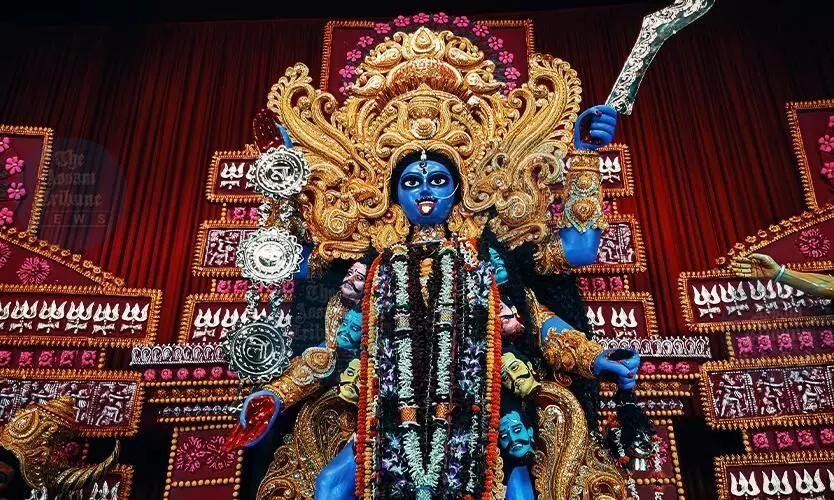Clothes and the Goddess
Soon, her garland of skulls began to cover her breasts. And now, in recent times, Kali is made to wear a sari! Could anything be more against the “idea” of Kali?

The worship of Kali, the Female Principle in her ferocious form, is celebrated in the darkness of Amavasya, a month after Mahalaya, the start of the ten-day period leading to Bijoya Dashami, and the immersion of Durga’s image.
Guwahati, Nov 4: In this season of gentling temperatures, it is perhaps appropriate that the Female Principle is worshipped in different forms across our country. True, this worship of Goddesses differs in significant ways according to the geographical location. And yet, in essence, this is “Devi Pakshya”: the time of worship for goddesses.
Beginning with the pomp and grandeur of Durga Puja, through Lakshmi and Jagatdhatri Pujas, right upto Saraswati Puja at the end of winter, Hindus worship different aspects of the Female Deity. In between these comes Kali Puja. The worship of Kali, the Female Principle in her ferocious form, is celebrated in the darkness of Amavasya, a month after Mahalaya, the start of the ten-day period leading to Bijoya Dashami, and the immersion of Durga’s image. The worship of Kali is mostly seen in the easternmost parts of the country. North India, where patriarchy rules stronger than it does in Bengal, Assam, and Orissa, does not celebrate Kali Puja. Instead, this is the time to worship another goddess, Lakshmi, and celebrate in the form of Diwali.
But we in Assam worship Lakshmi—our very own Ma Lokkhi—on the full moon night right after Durga Puja. Lakshmi, for us, is no doubt the goddess of wealth, but she is also a domestic goddess. She is not, for us, associated with the opening of new books of accounts, and worship for business prosperity, possibly because we were not in the past a business community.
Significantly, the worship of Kali, for us, takes place in darkness. For she is the Dark Goddess, the goddess of Time. She is also a protector, the Ma of the eighteenth century composer, mystic and devotee Ramprasad Sen. She is celebrated, in all her fearsome majesty, through Shyama Shongits, and ritual worship that often borders on the secretive. Red joba flowersare placed at her feet. And, less admirable but a testament to Kali’s power, is the fact that she was the deity worshipped by the fearsome dacoits of Bengal.
Kali, it is said, sprang from the forehead of Ma Durga, fully formed and as dark as night. She was brought into existence because of Durga’s wrath.
Her iconography highlights her terrible majesty. She is proudly naked, with a full bodied womanly persona. With streaming hair, four or six arms bearing skulls and weapons, her red tongue hanging out, and a garland of human skulls, she is fearsome. As she rampaged through the three worlds in fury, destroying everything in her path, it took the act of Shiva placing himself below her feet to pacify her. Her tongue, red with, it seems, a life of its own, hangs out as she realises what she has done.
Besides the religious aspects, Kali, for many, men and women both, is a symbol of power, of female emancipation. She is an inspiration for those who worship her complete nonchalance regarding prevailing societal norms. Tantrics worship her with mysterious rites, but there are others whose admiration for what she represents is not religious. There was, for instance the feminist publishing house, named Kali for Women.
Kali, not born, like Durga, from the powers of male Gods. Kali, who roams around cremation grounds after sunset.Kali, as black as night, Kali, she whose depiction does not, in any way, pander to the Male Gaze.
There is something about the Kali image, though, that in recent times seems to be evoked a sense of misplaced prudery in the organisers of the community Pujas. Gradually, over the years, Kali was made to wear a loin cloth. Soon, her garland of skulls began to cover her breasts. And now, in recent times, Kali is made to wear a sari! Could anything be more against the “idea” of Kali? In many pandals in the city, she is beginning to look like a badly dressed hag. Even her garland of skulls has vanished, to be replaced by insipid floral ones.
The truth is that the depiction of Kali has never been suited to the Male Gaze. It takes a person like Ramprasad Sen to sing her praises. For other men, her nakedness, her stance, does not jell with their idea of what a female body should look like. There is a sense of misplaced prudery, of a “bhadralok”; middle class mindset. Kali is not quiescent., she cannot be tamed by mere mortals. While the Male Gaze is quite okay with depictions of scantily clad white women on Hollywood posters, it is uncomfortable with Kali’s gorgeous, darkly-glowing nakedness. For Kali, and the idea of her, go against patriarchy.
Fortunately, no matter how much they begin to cover her up, there remain many other traditional images where she stands tall and proud in her dusky nudity. .
And therein lies hope.
By-
Mitra Phukan
